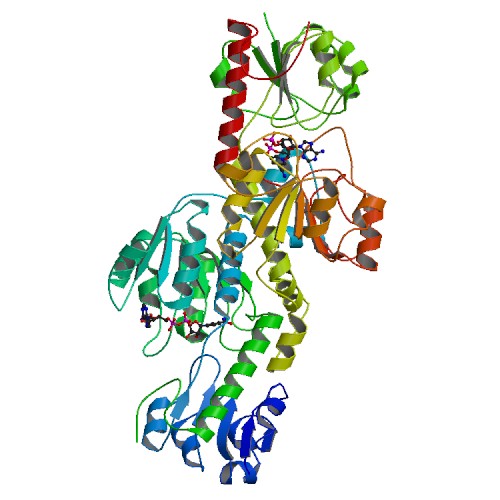CTBP2
| C-terminal binding protein 2 | |||||||||||||
|---|---|---|---|---|---|---|---|---|---|---|---|---|---|
 PDB rendering based on 2ome. | |||||||||||||
| |||||||||||||
| Identifiers | |||||||||||||
| Symbols | CTBP2 ; | ||||||||||||
| External IDs | Template:OMIM5 Template:MGI HomoloGene: 75187 | ||||||||||||
| |||||||||||||
| Orthologs | |||||||||||||
| Template:GNF Ortholog box | |||||||||||||
| Species | Human | Mouse | |||||||||||
| Entrez | n/a | n/a | |||||||||||
| Ensembl | n/a | n/a | |||||||||||
| UniProt | n/a | n/a | |||||||||||
| RefSeq (mRNA) | n/a | n/a | |||||||||||
| RefSeq (protein) | n/a | n/a | |||||||||||
| Location (UCSC) | n/a | n/a | |||||||||||
| PubMed search | n/a | n/a | |||||||||||
C-terminal binding protein 2, also known as CTBP2, is a human gene.[1]
This gene produces alternative transcripts encoding two distinct proteins. One protein is a transcriptional repressor, while the other isoform is a major component of specialized synapses known as synaptic ribbons. Both proteins contain a NAD+ binding domain similar to NAD+-dependent 2-hydroxyacid dehydrogenases. A portion of the 3' untranslated region was used to map this gene to chromosome 21q21.3; however, it was noted that similar loci elsewhere in the genome are likely. Blast analysis shows that this gene is present on chromosome 10.[1]
References
Further reading
- Chinnadurai G (2002). "CtBP, an unconventional transcriptional corepressor in development and oncogenesis". Mol. Cell. 9 (2): 213–24. PMID 11864595.
- Schaeper U, Boyd JM, Verma S; et al. (1995). "Molecular cloning and characterization of a cellular phosphoprotein that interacts with a conserved C-terminal domain of adenovirus E1A involved in negative modulation of oncogenic transformation". Proc. Natl. Acad. Sci. U.S.A. 92 (23): 10467–71. PMID 7479821.
- Katsanis N, Fisher EM (1998). "A novel C-terminal binding protein (CTBP2) is closely related to CTBP1, an adenovirus E1A-binding protein, and maps to human chromosome 21q21.3". Genomics. 47 (2): 294–9. doi:10.1006/geno.1997.5115. PMID 9479502.
- Turner J, Crossley M (1998). "Cloning and characterization of mCtBP2, a co-repressor that associates with basic Krüppel-like factor and other mammalian transcriptional regulators". EMBO J. 17 (17): 5129–40. doi:10.1093/emboj/17.17.5129. PMID 9724649.
- Sewalt RG, Gunster MJ, van der Vlag J; et al. (1999). "C-Terminal binding protein is a transcriptional repressor that interacts with a specific class of vertebrate Polycomb proteins". Mol. Cell. Biol. 19 (1): 777–87. PMID 9858600.
- Holmes M, Turner J, Fox A; et al. (1999). "hFOG-2, a novel zinc finger protein, binds the co-repressor mCtBP2 and modulates GATA-mediated activation". J. Biol. Chem. 274 (33): 23491–8. PMID 10438528.
- Furusawa T, Moribe H, Kondoh H, Higashi Y (2000). "Identification of CtBP1 and CtBP2 as corepressors of zinc finger-homeodomain factor deltaEF1". Mol. Cell. Biol. 19 (12): 8581–90. PMID 10567582.
- van Vliet J, Turner J, Crossley M (2000). "Human Krüppel-like factor 8: a CACCC-box binding protein that associates with CtBP and represses transcription". Nucleic Acids Res. 28 (9): 1955–62. PMID 10756197.
- Yu X, Baer R (2000). "Nuclear localization and cell cycle-specific expression of CtIP, a protein that associates with the BRCA1 tumor suppressor". J. Biol. Chem. 275 (24): 18541–9. doi:10.1074/jbc.M909494199. PMID 10764811.
- Schmitz F, Königstorfer A, Südhof TC (2001). "RIBEYE, a component of synaptic ribbons: a protein's journey through evolution provides insight into synaptic ribbon function". Neuron. 28 (3): 857–72. PMID 11163272.
- Murakami A, Ishida S, Thurlow J; et al. (2001). "SOX6 binds CtBP2 to repress transcription from the Fgf-3 promoter". Nucleic Acids Res. 29 (16): 3347–55. PMID 11504872.
- Strausberg RL, Feingold EA, Grouse LH; et al. (2003). "Generation and initial analysis of more than 15,000 full-length human and mouse cDNA sequences". Proc. Natl. Acad. Sci. U.S.A. 99 (26): 16899–903. doi:10.1073/pnas.242603899. PMID 12477932.
- Turner J, Nicholas H, Bishop D; et al. (2003). "The LIM protein FHL3 binds basic Krüppel-like factor/Krüppel-like factor 3 and its co-repressor C-terminal-binding protein 2". J. Biol. Chem. 278 (15): 12786–95. doi:10.1074/jbc.M300587200. PMID 12556451.
- Valenta T, Lukas J, Korinek V (2003). "HMG box transcription factor TCF-4's interaction with CtBP1 controls the expression of the Wnt target Axin2/Conductin in human embryonic kidney cells". Nucleic Acids Res. 31 (9): 2369–80. PMID 12711682.
- Mirnezami AH, Campbell SJ, Darley M; et al. (2004). "Hdm2 recruits a hypoxia-sensitive corepressor to negatively regulate p53-dependent transcription". Curr. Biol. 13 (14): 1234–9. PMID 12867035.
- Castet A, Boulahtouf A, Versini G; et al. (2004). "Multiple domains of the Receptor-Interacting Protein 140 contribute to transcription inhibition". Nucleic Acids Res. 32 (6): 1957–66. doi:10.1093/nar/gkh524. PMID 15060175.
- Brandenberger R, Wei H, Zhang S; et al. (2005). "Transcriptome characterization elucidates signaling networks that control human ES cell growth and differentiation". Nat. Biotechnol. 22 (6): 707–16. doi:10.1038/nbt971. PMID 15146197.
- Gerhard DS, Wagner L, Feingold EA; et al. (2004). "The status, quality, and expansion of the NIH full-length cDNA project: the Mammalian Gene Collection (MGC)". Genome Res. 14 (10B): 2121–7. doi:10.1101/gr.2596504. PMID 15489334.
- Alpatov R, Munguba GC, Caton P; et al. (2005). "Nuclear speckle-associated protein Pnn/DRS binds to the transcriptional corepressor CtBP and relieves CtBP-mediated repression of the E-cadherin gene". Mol. Cell. Biol. 24 (23): 10223–35. doi:10.1128/MCB.24.23.10223-10235.2004. PMID 15542832.
| This protein-related article is a stub. You can help Wikipedia by expanding it. |